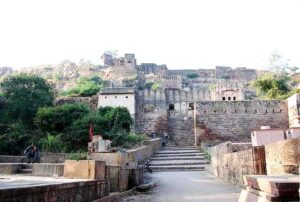
In and around Rajasthan State, western India, remain many Rajput forts. Among them six hill forts soaring from plains or cities were inscribed on the UNESCO World Heritage List in 2014.
These include Jaisalmer Fort, Amber Fort, Chittorgarh Fort, Kumbhalgarh Fort, Ranthambore Fort and Gagron Fort. Located in the undulating terrain of Aravalli Range, the forts are impressive for their tactical location, architectural brilliance, historic and cultural significance. Built between the 5th and 17th-18th centuries AD the forts belong to different Rajput Princely states. Each fort represents the fortified seat of power of the erstwhile royal dynasties.
|
The Hill Forts Of Rajasthan: UNESCO World Heritage Site In India |
||
|
Rank |
Hill Fort |
Location |
|
1 |
Chittorgarh Fort | 233 km from Ajmer, midway between Delhi and Mumbai on the National Highway 8 |
| 2 | Kumbhalgarh Fort | Rajsamand District, Rajasthan, India |
| 3 | Ranthambore Fort | Ranthambore National Park, Rajasthan, India |
| 4 | Gagron Fort | Jhalawar District of Rajasthan, India |
| 5 | Amber Fort |
Jaipur, Rajasthan, India. |
| 6 | Jaisalmer Fort | Jaisalmer, Rajasthan, India |
Outstanding Universal Value
The extensive fortifications up to 20 kilometres in circumference optimized various kinds of hilly terrain, specifically the river at Gagron, the dense forests at Ranthambore, and the desert at Jaisalmer, and exhibit an important phase in the development of an architectural typology based on established “traditional Indian principles”. The vocabulary of architectural forms and of ornaments shares much common ground with other regional styles, such as Sultanate and Mughal architecture. Rajput style was not ‘unique’, but the particular manner in which Rajput architecture was eclectic (drawing inspiration from antecedents and neighbours) together with its degree of influence over later regional styles (such as Maratha architecture) do make it distinctive.
Within the defensive walls of the forts, the architecture of palaces and other buildings reflects their role as centres of courtly culture, and places of patronage for learning arts and music. As well as housing for the court and military guard, most had extensive urban settlements within their walls, some of which have persisted to the present day. And some also had mercantile centres as the forts were centres of production and of distribution and trade that formed the basis of their wealth. Most of the forts had temples or sacred buildings, some pre-dating the fortifications and outliving the Rajput kingdoms, and many of these remarkable collections of buildings still attract followers. Collectively the forts contain extensive water harvesting structures, many of which are still in use.
As a former capital of the Sisodia clan and the target of three famous historical sieges, Chittorgarh is strongly associated with Rajput history and folk lore. Furthermore the sheer number and variety of architectural remains of early date (ranging from the 8th to the 16th centuries) mark it as an exceptional fort in its scale and monumentality comparable to very few other Indian forts. Kumbhalgarh was constructed in a single process and (apart from the palace of Fateh Singh, added later) retains its architectural coherence. Its design is attributed to an architect known by name –Mandan – who was also an author and theorist at the court of Rana Kumbha in Chittorgarh. This combination of factors is highly exceptional. Situated in the middle of forest, Ranthambore is an established example of forest hill fort and in addition, the remains of the palace of Hammir are among the oldest surviving structures of an Indian palace. Gagron is an exemplar of a river-protected fort. In addition its strategic location in a pass in the hills reflects it control of trade routes. Amber Palace is representative of a key phase (17th century) in the development of a common Rajput-Mughal court style, embodied in the buildings and gardens added to Amber by Mirza Raja Jai Singh I. Jaisalmer is an example a hill fort in desert terrain. The extensive township contained within it from the outset, still inhabited today, and the group of Jain temples, make it an important (and in some respects even unique) example of a sacred and secular (urban) fort.
Criterion (ii): The Hill Forts of Rajasthan exhibit an important interchange of Princely Rajput ideologies in fort planning, art and architecture from the early medieval to late medieval period, within the varied physiographic and cultural zones of Rajasthan. Although Rajput architecture shared much common ground with other regional styles, such as Sultanate and Mughal architecture, it was eclectic, drawing inspiration from antecedents and neighbours, and had a degree of influence over later regional styles such as Maratha architecture.
Criterion (iii): The series of six massive hill forts are architectural manifestations of Rajput valour, bravery, feudalism and cultural traditions, documented in several historic texts and paintings of the medieval and late medieval period in India. Their elaborate fortifications, built to protect not only garrisons for defence but also palatial buildings, temples, and urban centres, and their distinctive Rajput architecture, are an exceptional testimony to the cultural traditions of the ruling Rajput clans and to their patronage of religion, arts and literature in the region of Rajasthan over several centuries.
Source:
http://whc.unesco.org/en/list/247
https://www.indianholiday.com/tourist-attraction/rajasthan/hill-forts-of-rajasthan.html


